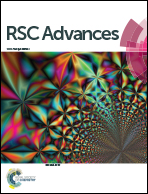Composition design, electrical properties, and temperature stability in (1 − x)K0.44Na0.56Nb0.96Sb0.04O3-xBi0.45La0.05Na0.5ZrO3 lead-free ceramics
Abstract
In this work, we designed a new system of (1 − x)K0.44Na0.56Nb0.96Sb0.04O3-xBi0.45La0.05Na0.5ZrO3 (KNNS-xBLNZ, 0 ≤ x ≤ 0.06) ceramics, and systemically investigated both their electrical performance and temperature stability. Through optimizing the composition, a relatively good comprehensive performance (e.g., d33 ∼ 455 ± 10 pC N−1, kp ∼ 0.47 ± 0.02, TC ∼ 266 °C, strain ∼ 0.148%, and  ) is obtained in the ceramics with x = 0.040, which is attributed to the construction of a rhombohedral–orthorhombic–tetragonal (R–O–T) phase boundary. Moreover, a good temperature stability of remnant polarization (Pr) as well as strain value (Pr100 °C/PrRT ∼ 89.6%, Pr180 °C/PrRT ∼ 73.2%, S100 °C/SRT ∼ 92.6%, S180 °C/SRT ∼ 74.1%) is gained in KNNS-0.040BLNZ ceramics with a broad temperature range from room temperature to 180 °C. Hence, we believe that KNNS-xBLNZ ceramics opens a window for the practical application of lead-free ceramics.
) is obtained in the ceramics with x = 0.040, which is attributed to the construction of a rhombohedral–orthorhombic–tetragonal (R–O–T) phase boundary. Moreover, a good temperature stability of remnant polarization (Pr) as well as strain value (Pr100 °C/PrRT ∼ 89.6%, Pr180 °C/PrRT ∼ 73.2%, S100 °C/SRT ∼ 92.6%, S180 °C/SRT ∼ 74.1%) is gained in KNNS-0.040BLNZ ceramics with a broad temperature range from room temperature to 180 °C. Hence, we believe that KNNS-xBLNZ ceramics opens a window for the practical application of lead-free ceramics.



 Please wait while we load your content...
Please wait while we load your content...